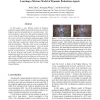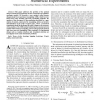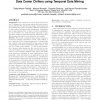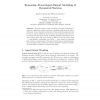2918 search results - page 12 / 584 » Learning qualitative models from numerical data |
CVPR
2012
IEEE
11 years 10 months ago
2012
IEEE
In this paper, a new Mixture model of Dynamic pedestrian-Agents (MDA) is proposed to learn the collective behavior patterns of pedestrians in crowded scenes. Collective behaviors ...
PPL
2008
13 years 7 months ago
2008
This paper investigates the influence of the interconnection network topology of a parallel system on the delivery time of an ensemble of messages, called the communication scheme...
TNN
2008
13 years 7 months ago
2008
This paper addresses the problem of the optimal design of numerical experiments for the construction of nonlinear surrogate models. We describe a new method, called learner disagre...
KDD
2009
ACM
14 years 8 months ago
2009
ACM
Motivation: Data centers are a critical component of modern IT infrastructure but are also among the worst environmental offenders through their increasing energy usage and the re...
IDA
1999
Springer
13 years 12 months ago
1999
Springer
The goal of input-output modeling is to apply a test input to a system, analyze the results, and learn something useful from the causeeffect pair. Any automated modeling tool that...




